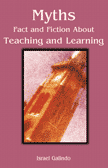The following is from the book Myths: Fact and Fiction about Teaching and Learning by Israel Galindo. How well do you know fact from fiction?
Fiction: All truths in science are based on empirical evidence.

Fact: Not everything that science holds as true is based on observable phenomena. For example, no one has actually seen a quark. With their customary aplomb, however, theorists turned necessity into a virtue and produced theories in which quarks are never supposed to be seen at all!
In a recent interview physicist and priests John Polkinghorne responded to a question about whether he regretted leaving the field of physics. He said he didn’t and that one reason is “that the subject has changed. All the time I was in physics, the field was driven by experimentation. There were lots of very clever theorists around, but the experimentalists provided the motivation. Since then the subject has become very speculative, with little empirical input. That’s actually not good for physics. . . .â€*
The idea of quarks comes from the notion that elementary particles weren’t really elementary after all, but were made from things that were more elementary. Currently, scientists believe there exist six quarks. They are named (I’m not making this up) Up, Down, Strange, Charmed, Bottom, and Top, Curly and Shemp (I made up the last two, but the others are real).
Fiction: Using competition in learning activities is a poor teaching method because it causes stress and creates winners and “losers.â€
Fact: Using competitive activities in learning interaction is not necessarily a poor teaching method merely because it causes stress. Remember that dissonance and anticipation are requisite conditions for learning. Learning interactions can fall into three categories: individual, competitive, and interactive. Each has its use.
- In the Individual approach (I do my own thing by myself) learners strive for their own individual success, which ultimately may not benefit the group.
- Competitive interaction (win-lose) causes learners to strive to do better than others. One learner’s success is another’s failure. Learners work against each other in achieving a goal, but ultimately everyone learns together. They key here is for the teacher to help ensure that the right things are learned.
- Cooperative interaction (all for one and one for all), calls for learners to work together to accomplish shared goals. They learn with and from one another. Group success and interdependence is celebrated. Learners see each other as resources for the learning process.
A good teacher will know how to use each interaction approach appropriately. And as for creating a winners-losers scenario, remember that experience is the best teacher. But it doesn’t end there, a wise teacher will help the learner throw away the experience and keep the lesson learned. Being stuck in an experience (“We lost and it didn’t feel goodâ€) isn’t very helpful, but keeping the insight learned from the experience is invaluable. You only lose if you don’t learn.

You can order a copy of the book Myth: Fact and Fiction about Teaching and Learning by Israel Galindo (ISBN 0-9715765-4-8) directly from Educational Consultants (this book will soon be available on Amazon.com).
*Michael Fitgerald, An Interview with John Polkinghorne: Physicist and priest. The Christian Century (January 29, 2008), p. 30.
